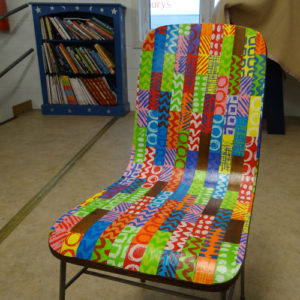We are delighted to have Sue Brown joining us for her signature workshop next Autumn! We asked Sue to tell us about her work and processes:
I am Sue Brown and have been an artist/printmaker for nearly 20 years. I live and work in Cheltenham, Gloucestershire and drive a 2CV.

What kind of printmaking do you do?
My specialism is Collagraph printmaking. Collagraph is an intaglio printmaking process which involves making a collage combining DIY filla, carborundum
and found textures. The technique produces prints with deeply textural surfaces.

How and where did you learn to print?
I learnt to do etching in the early 80’s when I studied for a fine art degree at Bristol Polytechnic. It was when I returned to teaching adults art in
a college of Further education after having 3 children that I discovered collagraph. I was checking out art departments after a career break of 10
years and discovered collagraphs being made at the local Stiener school, I introduced the technique to my adult learners and have been a technique
magpie ever since. I continually add new processes, materials and ideas to this flexible way of printmaking. In 2012 I graduated with a Multi Disciplinary
Printmaking MA from the University of the West Of England (Bristol Poly with another name).

Why printing?
I love the stages of plate making, inking and printing. I am a hands on sort of person and I enjoy the practical problem solving that only printmaking
offers me.

Where do you work?
I used to have a studio in the cellar of my house, then moved it into a posh garden shed. 2 years ago I took the step of renting a studio with a teaching
space just up the road from where I live. I can still get there in my pajamas but only in the dark so the neighbors don’t see.

Describe a typical day in your studio.
I would love to say there is a typical day, but in reality it varies unless I have a teaching day. If I am plate making or editioning I will start early,
lots of coffee will be involved and radio 4 will always be on.

How long have you been printmaking?
Professionally I have been printmaking for nearly 20 years, but I have been working on and off since art college in 1979.

What inspires you?
All things ornithological.

What products do you use? What product/tool could you not be without?
At the moment I love Hawthorn inks, their metallic inks are gorgeous. I cannot live without my Art Equipment press, I was able to buy it 20 years ago by
cashing in an insurance policy.

What have you made that you are most proud of?
A full sized collagraph of an Ostrich. Printed at the Cheltenham Ladies College who have a press the size of a double bed.

Where can we see your work? Where do you sell?
The last 2 years I have been fortunate enough to have been asked to demonstrate in the printmaking tent at Art in Action, Oxfordshire. My work can be seen
in several galleries around the country from Much Wenlock to Bristol, Lancaster to Godalming. This autumn I have had 2 collagraphs selected for the
RWA’s 164 Annual Open Exhibition in Bristol.

What will we be seeing from you next?
I am planning to explore birds perching on heads and create a series of textural pieces using polyfilla and carborundum. It is Cheltenham Open Studios
in 2017 and I want a new body of work that might surprise.

Do you have any advice for other printmakers and creatives?
I like the advice novelist Neil Gaiman gives to creatives: There are 3 things that make a good artist, being on time, making good work and being nice…but
you do not have to be all 3 at the same time. If you are late, but are nice and make good work you will be forgiven. If you are on time and make good
work you will be forgiven for being a bit hard to deal with. If you are on time and nice to deal with they will still like your work even if it is
not so good.
I maintain however, above all do good work, keep doing good work, you get no where without the work!!
To see more of Sue’s work, visit her website or The Yard Art Space. You can also keep up to date on Facebook and Twitter.
Click here for more information about Sue Brown’s
Mixed Media Sketch Book Techniques Workshop at Handprinted.







































